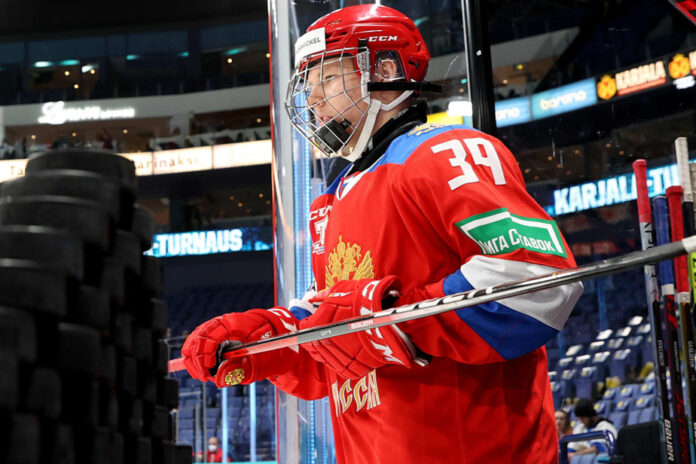The Canadian could be faced with a major dilemma in the draft. The question will obviously not arise if he wins the lottery, but a possible Nikita Kucherov could still be available at the fifth or sixth rank.
Matvei Michkov would arguably be the second overall pick had he been born elsewhere. Many have nicknamed him the “Russian Connor Bedard” for several years.
Not only is Russia mired in a war denounced by the rest of the world, but Michkov is bound by contract with the KHL until 2026. And who knows what will happen between now and then in the homeland of the autocrat Vladimir Poutine.
Michkov’s father, Andrei, died at age 51 in unclear circumstances three weeks ago. He went out for an errand and was found at the bottom of a lake a few days later. We still do not know the causes of his death and it is impossible to link him to hockey or his son even if some have dared to embark on speculation.
Like the main candidates for the 2023 draft, Bedard, Adam Fantilli or Leo Carlsson, Michkov, a winger, is not participating in the World Under-18 Championship this week. Not only is Russia still banned from international competitions, but Michkov turned 18 in December.
When the Russians last participated in this U18 Championship, in 2021, Michkov, aged just 16, finished first in scoring with 16 points, including 12 goals, in just 7 games, two points more than Shane Wright and …Connor Bedard.
Loaned in December to Sochi, the worst club in the KHL, by SKA St. Petersburg, Michkov has achieved what few Russian players manage to do at 18, not only play, but produce. He had 20 points in 27 games, ten less than the team leader, but in 28 fewer games!
In his draft-eligibility year, 2003-04, Alex Ovechkin had 24 points in 53 games with Dynamo Moscow. Kucherov had failed to establish himself in the KHL before making the leap to North America with the Rouyn-Noranda Huskies at age 19. Artemi Panarin didn’t establish himself in the KHL until he was 19, and he had 21 points, including five goals, in 40 games with Chekhov’s HC Vityaz.
The four clubs positioned ahead of the Canadian in anticipation of the lottery, Anaheim, Columbus, Chicago and San Jose, are all in reconstruction and could afford to draft Michkov even if it means waiting for him several seasons.
But some among them, less fond of risk, and, or, for moral reasons, could skip their turn and opt for a safer choice.
For the moral question, however, the Vasilevskiy, Shesterkin, Bobrovsky, Kucherov, Sergachev, Panarin, Orlov, Dadonov and company are at the heart of the series without any allusion to their nationality. Three Russians were also drafted in the first round in 2022, Pavel Mintyukov, Ivan Miroshnichenko and Danila Yurov.
At 5-foot-10 and 160 pounds, Michkov has a physique comparable to Kucherov’s, though he still concedes an inch and a few pounds. He is also reminiscent of Kucherov in some respects. Not only is he a prolific scorer, but he has exceptional game vision.
The Minnesota Wild waited a long time for Kirill Kaprizov. He drafted him in 2015. Numerous visits to Russia by team leaders did not convince the young man to cross the Atlantic until he was 23… five years later.
But the arrival of Kaprizov transformed the Wild. After a first season of 51 points, including 27 goals, in 55 games, in 2020-2021, he followed up with 108 points, including 47 goals, last year, and 75 points, including 40 goals, in 67 games this season .
He’s been criticized for his lack of productivity in the first round of the series between the Wild and the Stars, but Kaprizov is recovering from a season-ending injury.
The Michkov file will be one to watch by June. The young man repeats that he dreams of playing in the NHL. Let’s see where it ends up.
Does Andrei Vasilevskiy tend to allow more cookie goals? And would the Maple Leafs have discovered the flaw? Former NHL and American League goaltender Mike McKenna weighs in on the matter this week.
After checks, Vasilevskiy allowed eight of his last nine goals on this side, notes McKenna. And Toronto seems to be pulling more from that side for two games. In the first two games, 43% of the Leafs’ shots were aimed at the glove side, 37% at the biscuit side and 20% at the middle of the net, McKenna wrote, based on InStat Hockey statistics.
Toronto turned the tide in Games 3 and 4. They led 45% of the pucks biscuit side, 32% glove side and 20% in the middle of the goal. Eighteen of their high shots, above the pads, were directed on the biscuit side, against only nine on the glove side.
Vasilevskiy probably got wind of the story. Let’s see if it will serve as motivation for him in Game 5 on Thursday night or if it will help to entangle him further…
1— A half-hearted training camp helped lower expectations in the case of prospect Riley Kidney. He nevertheless had some splendid series with Gatineau, in the QMJHL. Katherine Harvey-Pinard made a jump to the Outaouais to speak with the young man and his entourage.
2—The top goaltender blundered and the dunce shone Wednesday night in Boston as the Panthers forced Game 6. Simon-Olivier Lorange’s analysis.
3 — For more on the NFL Draft, presented Thursday night, read Nicholas Richard!















